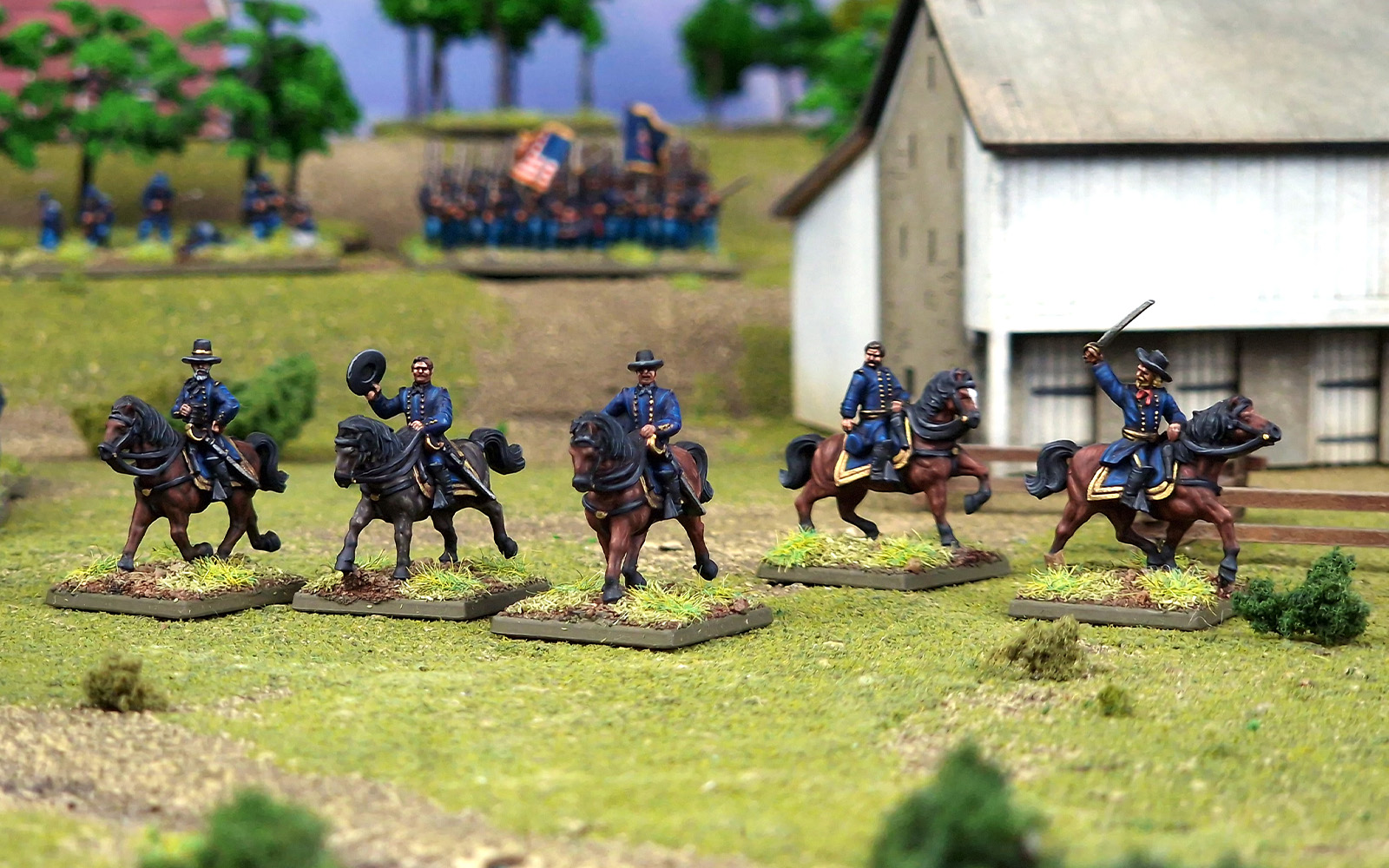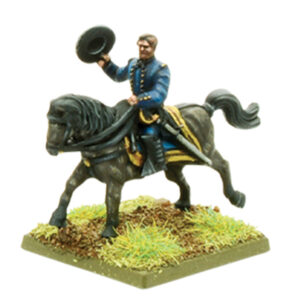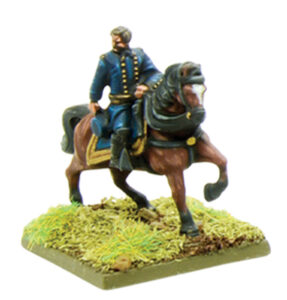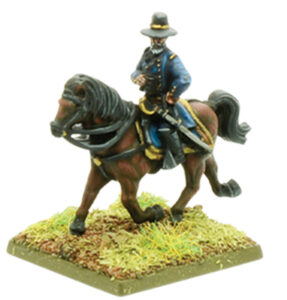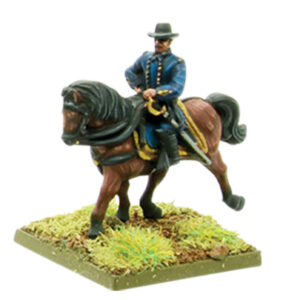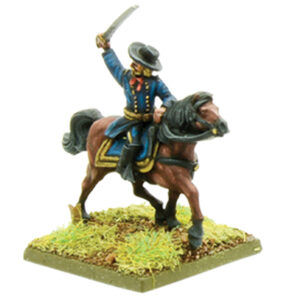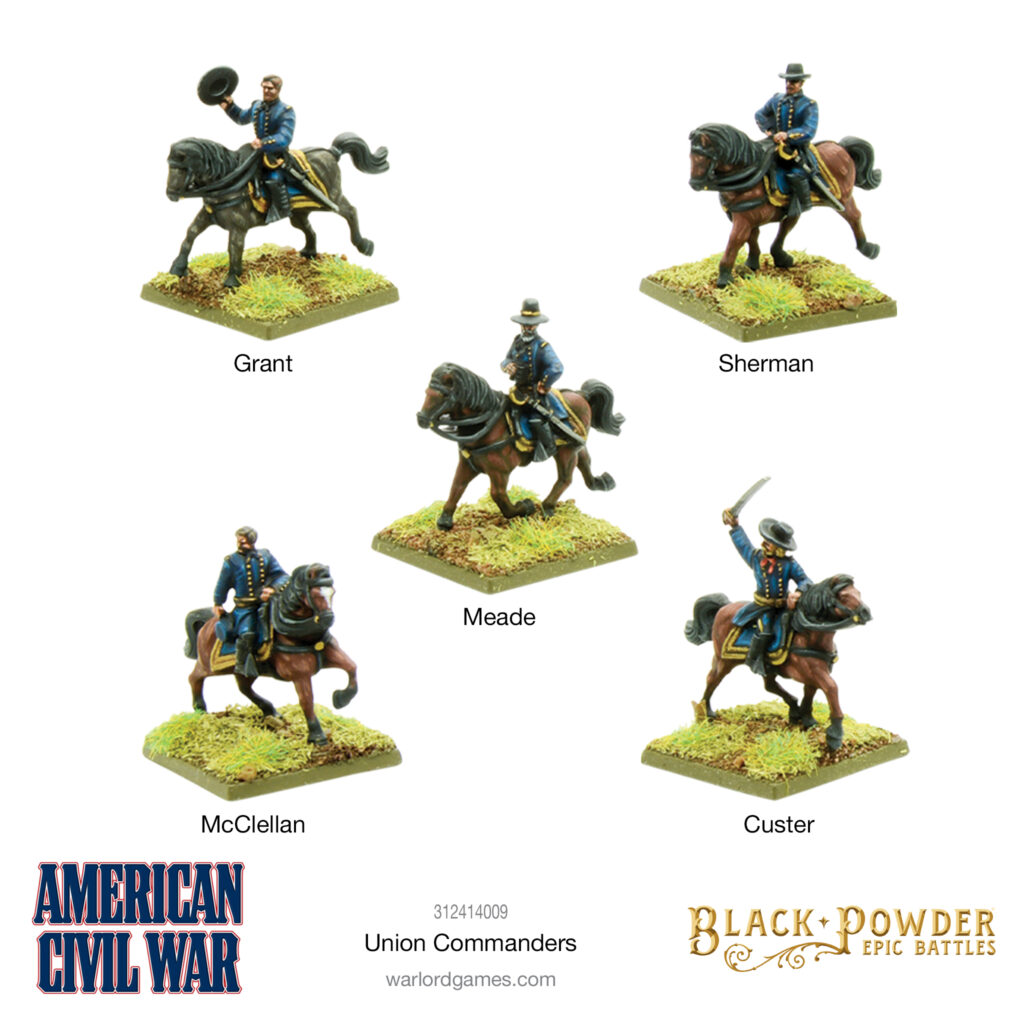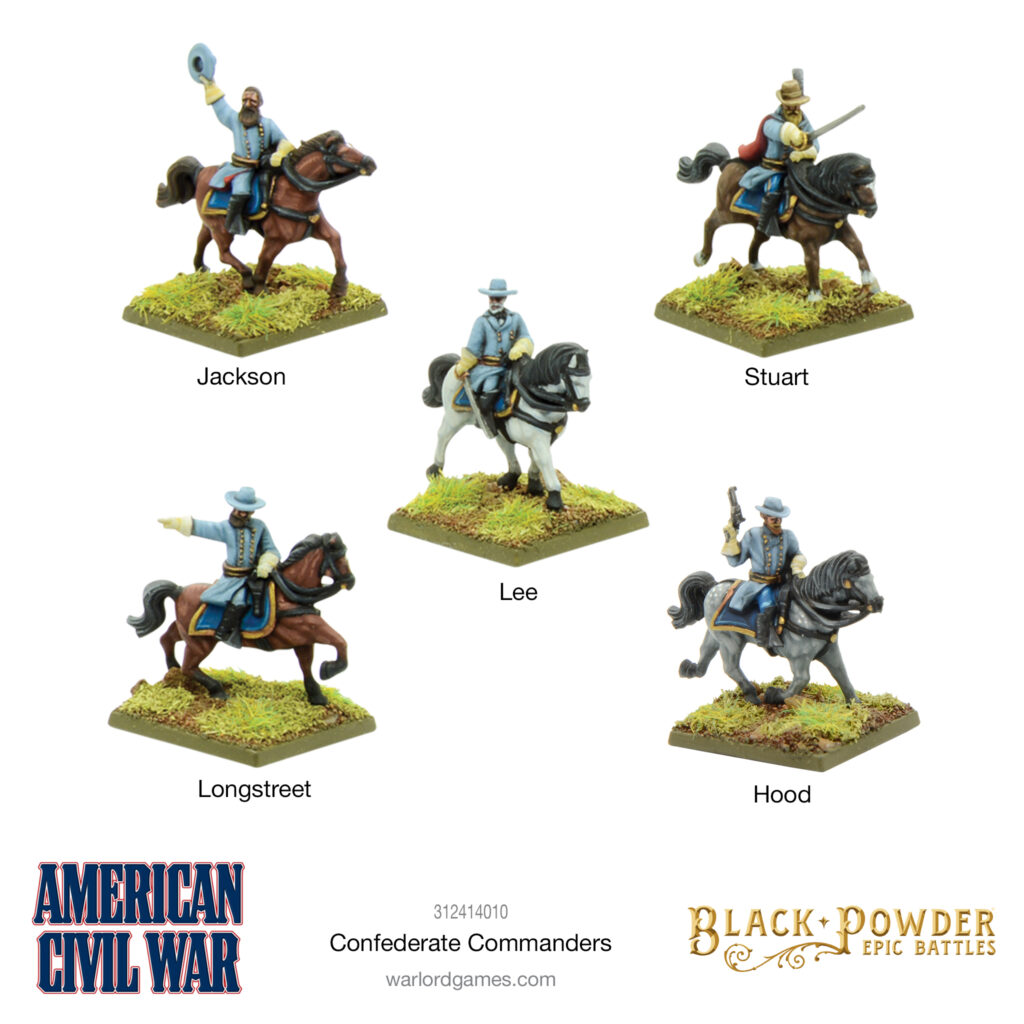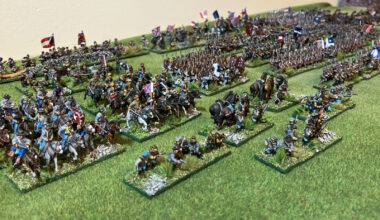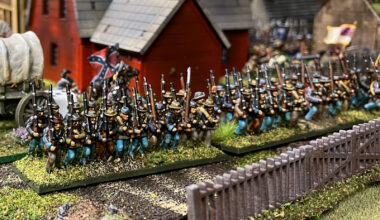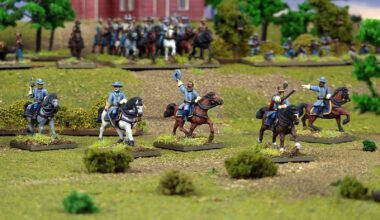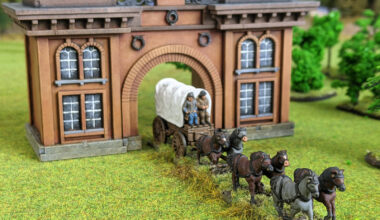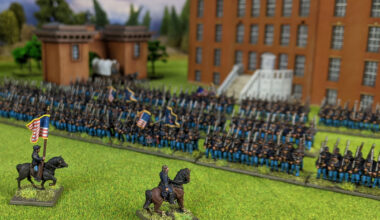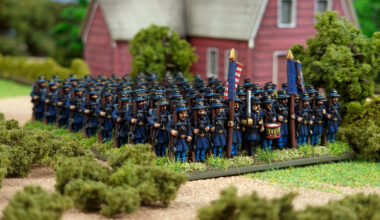Last time we looked at the Confederate commanders of the American Civil War, so it’s only fair that we take a look at their Union counterparts! Both infantry and cavalry commanders are accounted for, with plenty of special rules to complement the awesome new models!
Ulysses Simpson Grant
We’ll start at the top – Ulysses Simpson Grant. A graduate of the United States Military Academy at West Point, where he excelled in horsemanship, and a veteran of the Mexican-American War (like so many of his peers and adversaries), Grant had actually left the US Army in 1854, having developed a drinking problem while stationed away from his family in California. Several difficult years followed as Grant struggled to make a success of civilian life, but by 1860 he and his family were living comfortably in Galena, Illinois. When the Civil War broke out, Grant attended a recruitment speech given by his friend (and later Secretary of War) John Aaron Rawlins, and was moved to attempt to rejoin the Army. He was initially unsuccessful in securing a regular commission, but with the influence of Congressman Elihu B. Washburne was given a Volunteer commission and charged with training new recruits in Illinois for a time. He would then serve as a brigade commander before winning a string of early victories in Missouri and Tennessee, earning both a reputation as a determined general and a promotion to Major-General of Volunteers.
At Shiloh he was able to overcome early setbacks and come out with a victory, and in 1863 would secure Vicksburg. Further success followed, and by March 1864 Ulysses S. Grant was promoted to Lieutenant General, commander of all Union armies (a rank previously held only by George Washington). Meeting with Lincoln, he developed a strategy akin to the later concept of ‘total war’ against all aspects of the Confederacy, which he pursued against Robert E. Lee’s forces during the Overland campaign. While incurring enormous losses, particularly at Cold Harbour, Grant was able to deplete Lee’s forces and reduce his ability to counterattack with his Army of Northern Virginia, while elsewhere the Confederate forces suffered reverse after reverse and began to collapse. Finally, at Appomattox Court House on the 9th of April 1865, Grant cornered Lee’s forces and compelled him to surrender, effectively ending the war. Grant would later go on to serve two terms as President of the United States – not bad for a man who once had to resign from the US Army for being drunk on duty!
In games of Black Powder Epic Battles, Grant starts with a Command value of 8, but this increases to 9 in games set after 1862. In addition, he is Decisive, and to reflect his cool head any brigades (or indeed entire armies) that he commands will only become Broken when they have suffered more than 50 percent losses. West or East, he’s an ideal opponent for Lee as supreme commander of your Union forces.
George Brinton McClellan
Next we turn to a truly unusual man – George Brinton McClellan. A somewhat precocious youth, he attended West Point at the age of 15 and graduated second in his class. Following service in the Mexican-American war, he went on to observe the Crimean War, published a manual on bayonet tactics, surveyed numerous railroads, and designed a cavalry saddle so successful it remains in service (albeit only for ceremonial purposes) to this day! He was also a keen student of classical military tactics, and was, if nothing else, exceptionally well-read on the matter! Resigning his commission in 1857, he went into the railway business, and made a brief foray into politics shortly before the outbreak of war.
With his experience and record, McLellan’s service was much in demand and by May 1861 he was a Major General, outranked only by Winfield Scott, the General-in-Chief, all by the age of 34! A pair of minor victories in western Virginia endeared him enormously to the Union public and earned him the sobriquet of “Little Napoleon” in some circles – something McLellan appears to have rather enjoyed. Following this, he was placed in command of the new Army of the Potomac, which he immediately set about turning into an exceptional fighting force. By November of 1861 he commanded 168,000 incredibly well-drilled and motivated men, with whom by all accounts he was very popular. In addition, with Winfield Scott’s retirement, McLellan was promoted to General-in-Chief, but his reluctance to utilise his new army, along with his open dislike of Lincoln, led to significant frustration in the higher echelons of Union command. This frustration led to a truly immortal quote from the President – “If General McClellan does not want to use the army, I would like to borrow it for a time.”
Although finally persuaded to launch his ambitious Peninsula campaign against Lee, McClellan again failed to act decisively, fearing (due to poor intelligence from his advisors) that he was facing overwhelming numbers of Confederates who could attack him at any moment. Although he was able to advance to within four miles of the Confederate capital of Richmond, Lee was repeatedly able to gain the upper hand over him, a state of affairs that would largely persist throughout 1862. Finally, after his failure to pursue Lee after the incredibly bloody Battle of Antietam, an exasperated Lincoln removed him from command. McClellan seemed to view his contribution to the war as a sound defeat of Lee, and having saved the Union – whatever the case, it cannot be denied that he was an excellent trainer of men and a fine logistician. After his dismissal, he became a bitter opponent of Lincoln, even running against him in the 1864 presidential election which he (rather predictably) lost.
If you can cajole McClellan onto your Epic Battles tabletop, he actually makes a perfectly fine commander! With a Command of 8 (albeit with the Hesitant rule, making him rather unlikely to get all of his orders off), he’s certainly competent enough. Most interestingly, however, he brings with him a ‘spare’ brigade of four infantry regiments, held in reserve just in case his imagined Confederate hordes show up! While this brigade cannot advance past the halfway point of the table, it’s certainly a useful addition to any Union army!
George Meade
The son of a wealthy Philadelphia merchant, George Gordon Meade was a distinguished veteran of the Mexican-American war and an accomplished civil engineer for the War Department, particularly in the fields of lighthouse design and coastal survey. Appointed a Brigadier General of Volunteers at the start of the war, his brigade performed well throughout the early war, though Meade was shot and wounded at Glendale. Recovering in time for Second Bull Run, he took temporary command of the Union I Corps, and at Fredericksburg his forces made the only breakthrough of Confederate lines, a feat for which Meade was promoted to Major General. Meade was given command of V Corps in the winter of 1862; in this capacity, he took part in the Gettysburg campaign under Joseph Hooker. When Hooker resigned command, Meade was appointed (much to his surprise) to command the Army of the Potomac, despite there being four generals within that army outranking him. Less than a week later, he would face Robert E. Lee (and defeat him decisively) at the Battle of Gettysburg, displaying excellent delegation and overall command skills, although he was criticized for his failure to follow up on the victory and pursue Lee’s forces. When Grant came east to take command, Meade served ably (if rather more cautiously), although his role in commanding the disastrous Battle of the Crater did somewhat tarnish his reputation (which was not helped by his notoriously short temper which earned him the nickname “Old Snapping Turtle”). Remaining in active service postwar, he died from pneumonia in November of 1872.
A solid if unspectacular commander for most of his career, Meade is represented on the tabletop with a Command of 8, and the Cautious rule reflects his careful style of command. Used well, perhaps he can pull off another victory in the vein of Gettysburg!
William Tecumseh Sherman
Possibly the most controversial of the famed Union generals was William Tecumseh Sherman. The foster son of a US Senator, Sherman was, like the vast majority of his contemporaries, a West Pointer, but saw service in the Second Seminole War in Florida rather than the Mexican-American War, as a junior officer. Failure to serve in Mexico seems to have hampered his military career prospects, despite a reasonably successful period of service where he was considered a good young officer. Frustrated with the slow pace of advancement in the peacetime army, he resigned his commission in 1853 and spent the next five years working across the country as a bank manager, before a brief (and mostly unsuccessful) stint as a lawyer. In 1859 he would take up the position of Superintendent at the Louisiana State Seminary of Learning & Military Academy (now known by the far snappier name of Louisiana State University) where he was well-liked. As the war loomed, Sherman became a vehement opponent of secession, warning that a civil war would be disastrous for the country and that the secessionist states would inevitably be defeated. In January 1861, he resigned from his position, and with the assistance of his younger brother (by now a Senator) obtained a commission as a Colonel in the US Army. At the battle of First Bull Run, he commanded a brigade of raw volunteer recruits, and acquitted himself admirably despite the Union defeat. Following the battle, he fell into a deep depression, asking to be relieved of duty, and reportedly contemplated suicide. Returning to duty in December 1861, he wrote to Ulysses S. Grant (despite being technically senior to him) asking to serve under him – a wish that was granted when he was assigned to command Grant’s 5th Division in March 1862. At Shiloh he was surprised by the Confederate attack, but remained cool and collected and was heavily involved in the Union counterattack the next day. He would later describe Shiloh as giving him a “new life”, with that battle marking the turning point of his military career.
For the next two years, Sherman served capably under Grant, from Vicksburg through Chattanooga to Atlanta (which he virtually burned to the ground), before embarking on his infamous March to the Sea campaign, leaving behind a swathe of destruction through Georgia on his way to the coast. He employed what could be considered an early form of ‘total war’ (although on a much more limited scale), as his forces plundered food and supplies and systematically destroyed railroad infrastructure as they went. This was followed by a similar campaign through the Carolinas, with Columbia, the capital of South Carolina, being burned to the ground after its capture. The true culprit of this arson has since been endlessly debated, but it is indisputable that Sherman’s fiery campaigns were a huge blow to Southern morale, and helped hasten the surrender of Confederate forces and ensure his status as a thoroughly controversial commander.
In games of Black Powder Epic Battles, he can be fielded as a commander in the East or West. In the West, where he was more famed, he has a Command value of 9 and the Decisive special rule, while for games set during his earlier Eastern campaigns he simply has a Command of 8. Either way, he’s the perfect sidekick for Grant, or a fine commander in his own right!
George Armstrong Custer
Finally we have a man far more famed for his exploits after the Civil War than during it – no mean feat, given his impressive war record! George Armstrong Custer was still at West Point when the war broke out, graduating from the shortened course at the bottom of his class. Saved from obscurity by the Union’s need for trained professional officers, Custer earned a reputation as a capable, aggressive cavalry officer in the early part of the war, serving as an aide to McClellan and later Alfred Pleasonton, and this saw him promoted Brigadier General of Volunteers in June 1863, at the age of only 23! Placed in command of the Michigan Cavalry Brigade (popularly called the ‘Wolverines’), Custer took to his new role with gusto, and despite his complete lack of senior command experience proved himself to be a natural handler of cavalry. At Gettysburg, the Wolverines made a number of bold charges against Jeb Stuart’s Confederate cavalry, which far outnumbered them, and earned Custer plaudits and promotion. This came at the cost of 257 men, the most casualties sustained by any of the Union cavalry brigades involved in the campaign. Service in the Shenandoah Valley followed, before Custer’s forces blocked Lee’s retreat at Appomattox Court House. Having rather grandly demanded (unsuccessfully) that General James Longstreet surrender the entire army to him, Custer was, however, present at the signing of the surrender itself, and was promoted to Major General at the end of the war. Remaining in service in peacetime, he of course became a legend and something of a tragic American hero when he met his end at the Battle of the Little Bighorn, also famously known as Custer’s Last Stand.
A flamboyant and aggressive type, Custer has a Command of 8, along with the Aggressive and Headstrong special rules – the perfect man to lead the Wolverines into battle!
Union and Confederate Commander packs for Black Powder Epic Battles: American Civil War are now available to order from the Warlord Games Webstore.
